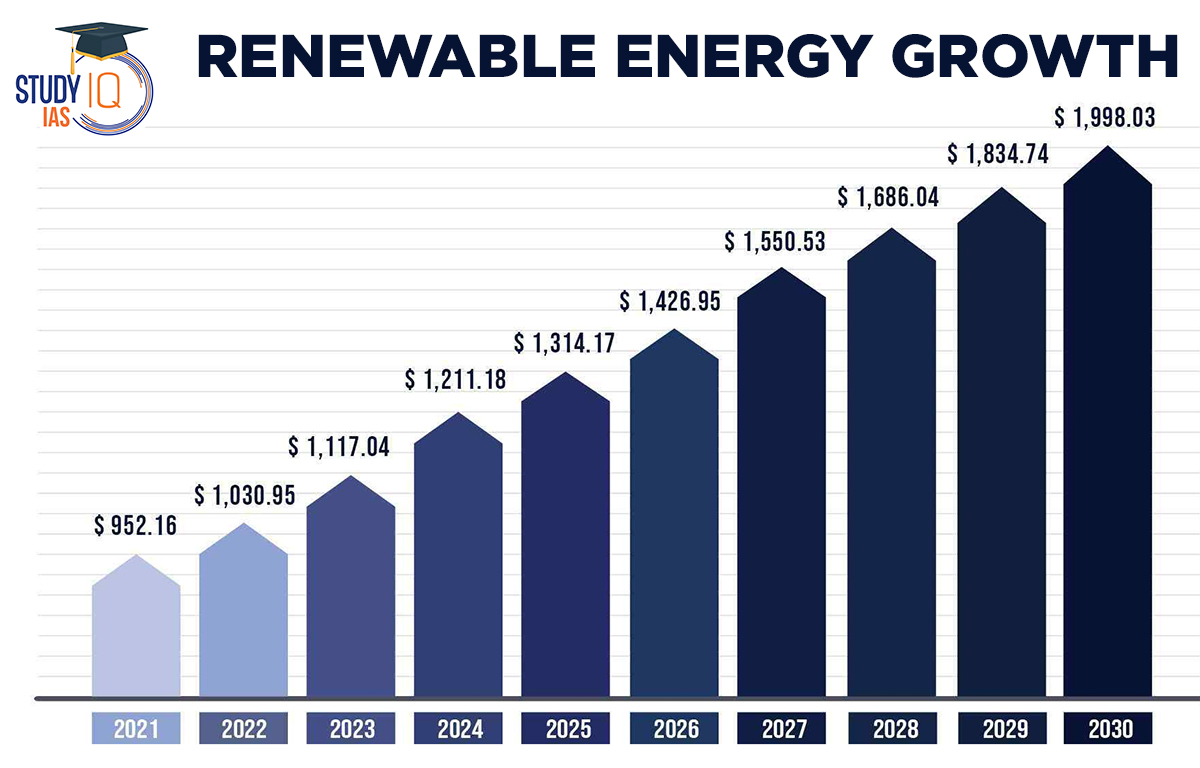Table of Contents
Important Findings of the Study
Global Scenario
Renewable Energy Growth
- Renewables will account for almost 40% of global electricity output in 2027, making up for declining shares of coal, natural gas and nuclear.
- The world’s renewable energy capacity addition will grow to 2,400 GW between 2022 and 2027.
- The study said this expansion was 85 per cent faster than the previous five years.
Composition of Growth
- Solar PV and wind will provide the vast majority of global renewable capacity additions by 2027.
- Solar PV will account for over 60% of all renewable capacity expansion.
Top Contributors
- The upward expansion is mainly driven by India, China, the European Union and the United States.
- China is forecast to install almost half of new global renewable power capacity over 2022-2027
Key Growth Drivers
- Energy Inflation: High fossil fuel and electricity prices resulting from the global energy crisis have made renewable power technologies much more economically attractive.
- The Europe Factor: Russia’s invasion of Ukraine has caused fossil fuel importers, especially in Europe, to increasingly value the energy security benefits of renewable energy.
- Favourable Policies: Market reforms, guidelines and favourable policies are ensuring the rapid expansion of renewables across the world. For example:
- In the United States, the Inflation Reduction Act is providing unprecedented long-term policy visibility for wind and solar PV projects.
- Policy guidelines and targets in China’s new 14th Five-Year Plan on renewable energy.
- Competitive and hybrid auctions in India to achieve the renewable energy targets.
- ‘REPowerEU’ plan by the European Commission to make Europe independent from Russian fossil fuels well before 2030.
India Related Findings
Background
- Updated NDCs: In September 2022, India updated its NDCs to UNFCCC in which India has planned to achieve about 50% of cumulative electric power installed capacity from non-fossil fuel-based energy resources by 2030.
- LT-LEDS: At the recently concluded UNFCCC’s COP 27, India has submitted its Long-Term Low Emission Development Strategy (LT-LEDS). It is India’s action plan to achieve net zero by 2070.
- Renewable Energy Expansion:
- With the addition of 145 gigawatt (GW), India is forecast to almost double its renewable power capacity over 2022-2027.
- Solar Photovoltaic (PV) accounts for three-quarters of this growth, followed by onshore wind with 15 per cent and hydropower providing almost all the rest.
- Favourable Policies: The report said consistent policy support from the Indian government may enable this transition, particularly by promoting local manufacturing of solar modules. For example,
- Import duties: In April 2022, duty on imports was increased to 40 per cent for PV modules from 15 per cent and to 25 per cent for solar cells. This was done to reduce dependence on China and increase domestic manufacturing.
- The Production Linked Incentive (PLI) scheme: A PLI scheme for PV manufacturing has been sanctioned to provide an ecosystem of local manufacturing. It aims to expand India’s solar PV cell and module manufacturing capacity to over 70 GW in this decade.
- Hybrid Projects: Almost a quarter of the renewable capacity awarded since 2021 has been contracted through hybrid auctions. These auctions are thus expected to be an increasingly important growth driver for India’s renewable expansion.
- Hybrid projects refers to innovative combinations of solar and wind power at a site. It can include solar, wind, and battery or pumped hydro storage. Bundling coal with renewables is also another option.
- However, the poor financial health of India’s DISCOMs continues to prevent faster renewable capacity deployment.
About the International Energy Agency
- It is a Paris-based autonomous intergovernmental organization which works with countries around the world to shape energy policies for a secure and sustainable future.
- Establishment: It was established in the wake of the oil crisis of 1973-1974, to help its members respond to major disruptions in oil supply.
- Objective: It mainly focuses on its energy policies which include economic development, energy security and environmental protection. These policies are also known as the 3 E’s of IEA.
- Important Reports: World Energy Outlook Report, World Energy Investment Report, World Energy Statistics and India Energy Outlook Report.


 Daily Quiz 11 July 2025
Daily Quiz 11 July 2025
 Operation Baam: Baloch Separatist Group ...
Operation Baam: Baloch Separatist Group ...
 Article 326 and Electoral Roll Revision ...
Article 326 and Electoral Roll Revision ...





















